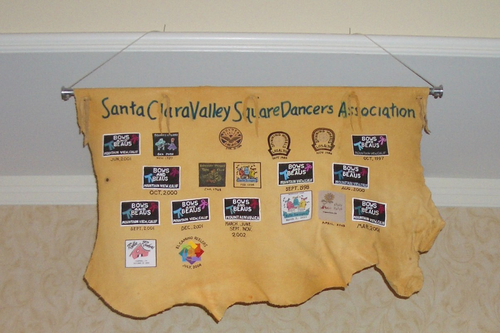The Guide to IAGSDC Convention Chapter 6
Notes for non-LGBT Dancers at an IAGSDC® Convention
There are a few significant differences between straight & LGBT square dance conventions. In 2006, Gloria Krusemeyer suggested that this would be a good topic to add to the Guide. This addition proved so popular that in 2007, it spurred the straight square dance community to ask me for permission to adapt the Guide to a straight audience attending non-IAGSDC conventions!
Straight dancers are welcome at IAGSDC Conventions. However, some of the IAGSDC® customs may seem a little weird to straight dancers at first.
LGBT dances are called at a faster pace. Don't be surprised to hear familiar callers using new or untraditional music you've never heard before. LGBT audiences generally prefer contemporary music with a faster beat. Callers will call much faster to an LGBT floor than to a straight floor.
APD/DBD is the norm for LGBT dancing. Since genders usually aren't balanced at LGBT square dance clubs, LGBT dancers don't pay any attention to physical gender vs. dance gender. Many LGBT clubs practice All Positions Dancing ("APD") and Dance By Definition ("DBD"). This means that callers may choose to use more sashayed or non-standard positions for familiar calls than you're used to.
Single dancers of either gender are always welcome at LGBT square dance functions. A surprising number of IAGSDC® attendees are straight dancers who no longer have a dance partner, but who have been made to feel welcome in LGBT square dance venues. At LGBT square dance functions, single dancers are the norm, not the exception. LGBT dancers dress very casually. Unlike most straight square dance functions, LGBT dancers don't have special costumes or dresses for dancing. Most LGBT dancers usually wear comfortable clothing, which could be anything from sweatpants or shorts to jeans or slacks. Shoes are usually whatever's most comfortable to walk in.
Because LGBT square dancing is often higher-energy than straight square dancing, short sleeved shirts are very common, as are T-shirts. Collared long-sleeve shirts for men and full crinolines for women are usually too warm to dance in for the faster and more intense pace of an LGBT floor.
Squaring up is a little different at IAGSDC® Conventions. People can square up as individuals as well as partners. There are no "computer" (pre-assigned) squares. Each tip is what the straight community calls "open squares".
To square up as a single, walk out onto the floor (preferably up front where the caller can see you, and will help you form a square if necessary), and hold up one or both of your hands as follows:
- If you want to dance the boy's part, stand in the boy's spot and hold up your right hand (because you're looking for a "girl" to take that hand).
- If you want to dance the girl's part, stand in the girl's spot hold up your left hand (because you're looking for a "boy" to take that hand).
- If you're bidansual (can dance either boy or girl), stand in the center on one side of a forming square and hold up both hands.
There are a number of dance fluff differences between the straight and LGBT dance communities. Just as LGBT dancers are instructed to use straight fluff at straight dances, it's considered polite to use LGBT fluff at LGBT dances. If you'd like to be shown how to do any of the fluff, such as "Weave The Ring", don't be afraid to ask the people in your square right after the tip is over. (Or the caller.)
LGBT dancers often hug each other after a tip. If you don't want to be hugged, hold out your hand to shake hands.
(Back to the Guide To IAGSDC Convention Table of Contents.) (Back to Guide Chapter 5.) (Forward to Guide Chapters 7-9.)
